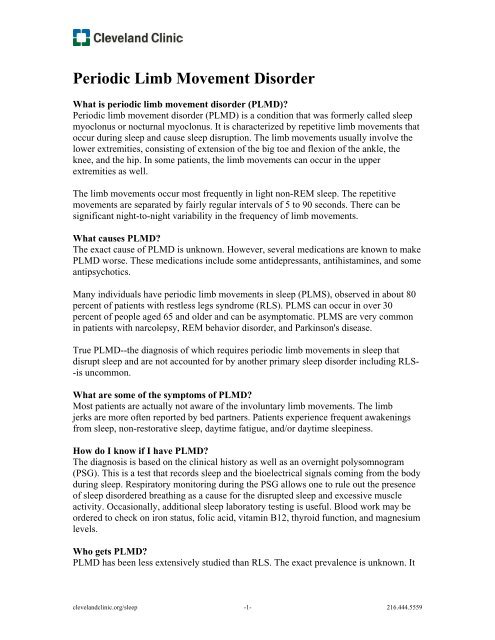Periodic Limb Movement Disorder - Cleveland Clinic
Periodic Limb Movement Disorder - Cleveland Clinic
Periodic Limb Movement Disorder - Cleveland Clinic
You also want an ePaper? Increase the reach of your titles
YUMPU automatically turns print PDFs into web optimized ePapers that Google loves.
<strong>Periodic</strong> <strong>Limb</strong> <strong>Movement</strong> <strong>Disorder</strong><br />
What is periodic limb movement disorder (PLMD)?<br />
<strong>Periodic</strong> limb movement disorder (PLMD) is a condition that was formerly called sleep<br />
myoclonus or nocturnal myoclonus. It is characterized by repetitive limb movements that<br />
occur during sleep and cause sleep disruption. The limb movements usually involve the<br />
lower extremities, consisting of extension of the big toe and flexion of the ankle, the<br />
knee, and the hip. In some patients, the limb movements can occur in the upper<br />
extremities as well.<br />
The limb movements occur most frequently in light non-REM sleep. The repetitive<br />
movements are separated by fairly regular intervals of 5 to 90 seconds. There can be<br />
significant night-to-night variability in the frequency of limb movements.<br />
What causes PLMD?<br />
The exact cause of PLMD is unknown. However, several medications are known to make<br />
PLMD worse. These medications include some antidepressants, antihistamines, and some<br />
antipsychotics.<br />
Many individuals have periodic limb movements in sleep (PLMS), observed in about 80<br />
percent of patients with restless legs syndrome (RLS). PLMS can occur in over 30<br />
percent of people aged 65 and older and can be asymptomatic. PLMS are very common<br />
in patients with narcolepsy, REM behavior disorder, and Parkinson's disease.<br />
True PLMD--the diagnosis of which requires periodic limb movements in sleep that<br />
disrupt sleep and are not accounted for by another primary sleep disorder including RLS-<br />
-is uncommon.<br />
What are some of the symptoms of PLMD?<br />
Most patients are actually not aware of the involuntary limb movements. The limb<br />
jerks are more often reported by bed partners. Patients experience frequent awakenings<br />
from sleep, non-restorative sleep, daytime fatigue, and/or daytime sleepiness.<br />
How do I know if I have PLMD?<br />
The diagnosis is based on the clinical history as well as an overnight polysomnogram<br />
(PSG). This is a test that records sleep and the bioelectrical signals coming from the body<br />
during sleep. Respiratory monitoring during the PSG allows one to rule out the presence<br />
of sleep disordered breathing as a cause for the disrupted sleep and excessive muscle<br />
activity. Occasionally, additional sleep laboratory testing is useful. Blood work may be<br />
ordered to check on iron status, folic acid, vitamin B12, thyroid function, and magnesium<br />
levels.<br />
Who gets PLMD?<br />
PLMD has been less extensively studied than RLS. The exact prevalence is unknown. It<br />
clevelandclinic.org/sleep -1- 216.444.5559
can occur at any age; however, the prevalence does increase with advancing age. Unlike<br />
RLS, PLMD does not appear to be related to gender.<br />
As with RLS, some medical conditions are associated with PLMD. These include uremia,<br />
diabetes, iron deficiency, and spinal cord injury.<br />
How is PLMD treated?<br />
First, certain products and medications should be avoided. Caffeine often intensifies<br />
PLMD symptoms. Caffeine-containing products such as chocolate, coffee, tea, and soft<br />
drinks should be avoided. Also, many antidepressants can cause a worsening of PLMD.<br />
Generally, there are several classes of drugs that are used to treat PLMD. These include<br />
dopaminergic agents (Parkinson’s disease drugs), anti-seizure medications,<br />
benzodiazepines, and narcotics. Current treatment recommendations consider the anti-<br />
Parkinson’s medications as a first line of defense. Medical treatment of PLMD often<br />
significantly reduces or eliminates the symptoms of these disorders. There is no cure for<br />
PLMD and medical treatment must be continued to provide relief.<br />
Resources:<br />
The <strong>Cleveland</strong> <strong>Clinic</strong> Guide to Sleep <strong>Disorder</strong>s by Nancy Foldvary-Schaefer, DO<br />
clevelandclinic.org/sleep -2- 216.444.5559

















